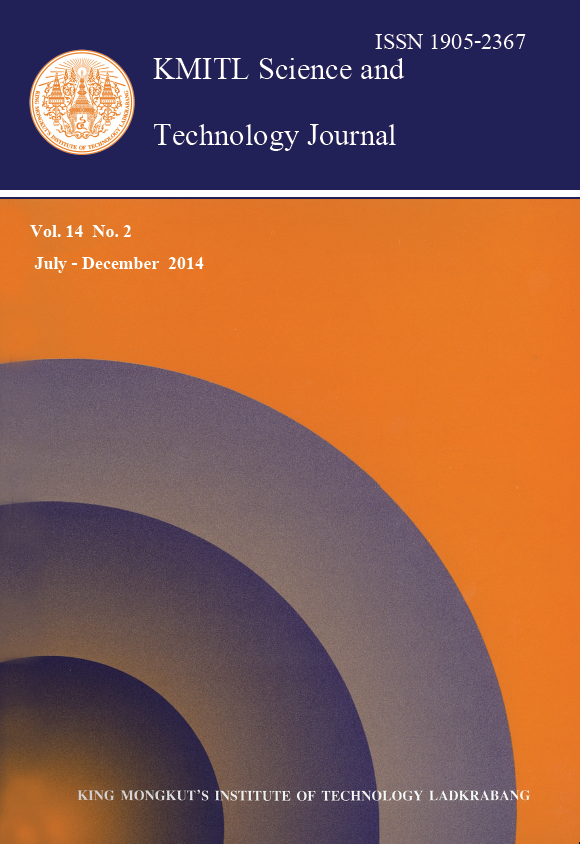A Comparative Study on Different Feeding Machines to Growth, Water Quality and Economic Performance in Nile Tilapia (Oreochromis niloticus) Commercial Farming
Main Article Content
Abstract
Acomparative study of two different feeding methods; fixed station feeder (AF) and mobile blower feeder (BF), on growth, water quality and economical performance in Nile Tilapia (Oreochromis niloticus) were done in earthen pond commercial farm in Petchaburi province, central Thailand. Monosex tilapias (average initial body weight of 300 g) were stocked in six 8000-11200 m2 earthen ponds at a density of ca. 1 fish/ m2 and cultured for 120 days. Fish were fed with a MN 11 commercial tilapia pellet feed (30% protein). Results showed survival, yield, body composition and feed utilization in fish fed using (AF) and (BF) were not statistically difference (P>0.05). However, growth performance was higher in fish fed using blower feeder. Distribution of fish in earthen pond during feeding time between 2 feeder machines was different. Most fish in pond fed using (AF) method aggregated near the outlet (feeding area), while the uniform distribution was observed in pond fed by (BF) method. There were no significant differences in almost all water quality parameters and perform at the optimal level. In addition, there was no significant difference in the economic performance between two feeding methods. Therefore, the (AF) might be the considerable options of feeding machine which can improve growth performance for Nile tilapia commercial farming.
Keywords: Fixed Station Feeder, Mobile Blower Feeder, Nile Tilapia, Growth, Commercial Farming
*Corresponding author: E-mail: kkmontho@gmail.com
Article Details
Copyright Transfer Statement
The copyright of this article is transferred to Current Applied Science and Technology journal with effect if and when the article is accepted for publication. The copyright transfer covers the exclusive right to reproduce and distribute the article, including reprints, translations, photographic reproductions, electronic form (offline, online) or any other reproductions of similar nature.
The author warrants that this contribution is original and that he/she has full power to make this grant. The author signs for and accepts responsibility for releasing this material on behalf of any and all co-authors.
Here is the link for download: Copyright transfer form.pdf
References
[2] Odoli, C.O. 2009. Optimal storage conditions for fresh farmed tilapia (Oreochromis niloticus) fillets, Iceland, Department of Food Science and nutrition.
[3] Department of Fisheries (DOF). 2011. Tilapia Development Strategy. Fisheries Economic Division.
[4] Josupeit, H. 2005. World market of tilapia. In: FAO. GLOBFISH Research Programme vol. 79. Rome, Fishery Industries Div.
[5] Lovell, R.T. 1998. Nutrition and feeding of fish. London, Kluwer Academic publisher.
[6] Cruz, P.S. 1997. Aquaculture Feed and Fertilizer Resource Atlas of the Philippines. FAO Fisheries Technical paper, 366, Rome, FAO.
[7] Hepher, B. and Pruginin, Y. 1981. Commercial fish farming with Special Reference to Fish Culture in Israel. New York, John Willey & Son.
[8] WWW http://www.clinictech.most.go.th/techlist/0214/agriculture/00000-53.html (Accessed 2014-10-20).
[9] Helrich, K. 1990. Official methods of analysis of the association of official analytical chemists. Arlington, The association of official analytical chemists, Inc.
[10] Hagerman Hatchery Evaluation Team. 2006. An evaluation of two different feeding methods for controlling growth of steelhead reared at a constant water temperature. Idaho, Hagerman Fish Culture Experiment Station.
[11] Casillas-Hernandez, R., Nolasco-Soria, H., Garcıa-Galano, T., Carrillo-Farnes, O. and Paez-Osuna, F. 2007. Water quality, chemical fluxes and production in semi-intensive Pacific white shrimp (Litopenaeus vannamei) culture ponds utilizing two different feeding strategies, Aquaculture engineering, 36, 105-114.
[12] Paspatis, M., Batarias, C., Tiangos, P. and Kentouri, M. 1999. Feeding and growth responses of sea bass Dicentrarchus labrax reared by four feeding methods. Aquaculture, 175, 293-305.
[13] Boujard, T. and Medale, F. 1994. Regulation of voluntary feed intake in juvenile rainbow trout fed by hand or by self-feeders with diets containing two different protein/energy ratios, Aquat. Living Resour., 7, 211-215.
[14] Diana, J.S., Lin, C.K. and Jaiyen, K. 1994. Pond dynamics under semi-intensive and intensive culture practices. In: Egna, H.S., Bowman, J., Goetze, B. and Weidner, N., Eleventh Annual Admistrative Report Pond Dynamics /Aquaculture Collaborative Research Support Program 1993. Oregon State University, Corvallis, OR, pp. 94-99.
[15] Aquaculture collaborative research. 1998. Intensification of Tilapia Production: Effects of Feeding at Different Stocking Rate on Pond Water Quality. Aquaculture Collaborative Research Support Program 1993. Oregon State University, Corvallis, OR.
[16] WWWhttp://www.fisheries.go.th/itnetwork/Exel/NILE%20TILAPIA%201.htm (Accessed 2014-10-20).
[17] Zakes, Z., Kowalska, A., Czernlak, S., and Demska-Zakes, K. 2006. Effect of feeding frequency on growth and size variation in juvenile pikeperch, Sander lucioperca (L.). Czech J. Anim. Sci., 51(2), 85-91.
[18] Paspatis, M. and Boujard, T. 1999. A comparative study of automatic feeding and self-feeding in juvenile Atlantic salmon (Salmo salar) fed diets of different energy levels. Aquaculture, 145(1-4), 245-257.
[19] Saoud, I. P., Davis, D. A., Roy, L. A. and Phelps, R. P. 2005. Evaluating the Benefits of Size- Sorting Tilapia Fry Before Stocking. Journal of Applied Aquaculture, 17(4), 73-85.
[20] WWW http://www.bennex.com/?page=1171&show=1335 (Accessed 2014-10-20).
[21] Helfman, G. 1993. Fish behaviour by day, night, and twilight. In: Pitcher, T.J. (Ed.), The Behavior of Teleost Fishes, London, Croom Helm, pp. 336– 387.
[22] Almazan-Rueda, P., Schrama, J.W. and Verreth, J.A.J. 2004. Behavioural responses under different feeding methods and light regimes of the African catfish (Clarias gariepinus) juveniles, Aquaculture, 231(1-4), 347-359.
[23] Lawson, T.B. 1995. Fundamentals of Engineering. New York, Chapman and Hall.
[24] Egna, H.S. and Boyd, C.E. 1997. Dynamics of pond aquaculture. Florida, Boca Raton.
[25] Fast, A.W. 1986. Pond production system: water quality management practices. In: Lannan, J.E., Smitherman, R.O. and Tchobanoglous, G. Principles and practices of pond aquaculture. Oregon, Oregon State University Press, pp. 146-167.
[26] Coche, A.G., Muir, J.F. and Laughlin, T. 1996. Management for freshwater fish culture: Ponds and water practices., In: FAO Training Series (21/1).
[27] Advancefarma company. 2008. Relative safety point of total ammonia nitrogen at pH range and temperature range. Advancefarma company. Bangkok, Thailand.
[28] Muir, J.F. and Roberts, R.J. 1982. Recent advances in aquaculture. United States of America, Westview Press, Inc.


